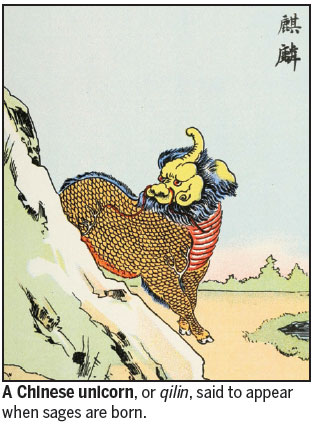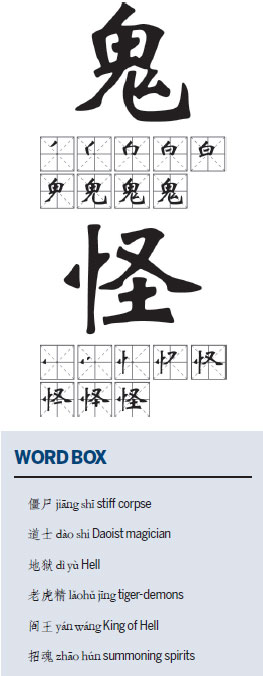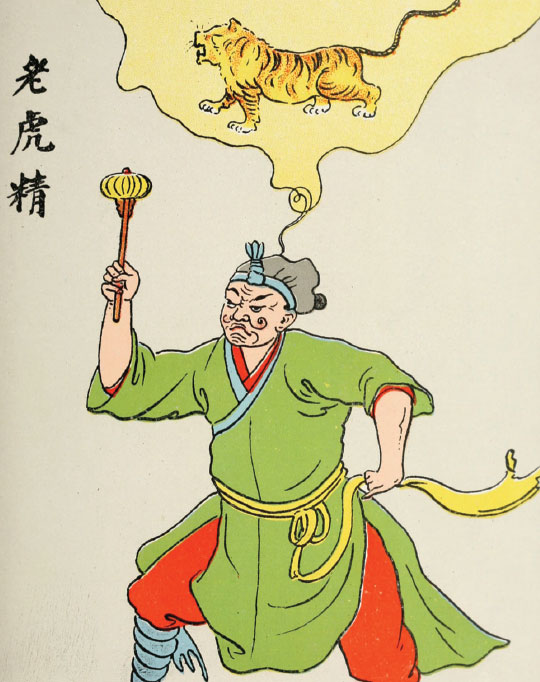China's grim fairy tales

Vampires, ghosts and terrifying beasts: How foreign demonologists catalogued country's homegrown horrors
The tale, over a century old, starts simply: A researcher asks a former governor why he keeps moving his arms, as if swinging bells.
The answer: vampires.
Dutch demonologist Jan Jakob Maria de Groot was researching China's supernatural history in 1907 when he interviewed "Tsiang", who claimed to be a governor of a town in Pehchihli (most likely modern-day Hebei) that was under siege by a kiang shi, or Chinese vampire - jiangshi (僵尸, "stiff corpse") in modern Romanization.
| A depiction of a were-tiger, or chu tu-shi. Images Provided to China Daily |
These "living corpses", de Groot explains, "break forth from their tombs and satiate their cravings for human blood".
Pehchihli was apparently under siege by a creature "soaring through the air, to devour the infants of the people". Despite residents locking their doors at nightfall, children were going missing. The town pooled money for a Daoist magician, who set up his altar on an auspicious day. Tsiang demanded to know how, precisely, he planned to stop this marauding vampire.

"Corpse specters generally fear very much the sound of jingles and hand-gongs," the magician told him. "When the night comes, you must watch the moment when the specter flies out and forthwith enter the grave with two big bells." But there were risks: "Do not stop ringing them, for a short pause will give suffice for the corpse to enter the grave, and you will then be the sufferer."
At midday, a crowd gathered and trapped the kiang shi in their midst. As the magician performed his rites, the governor doggedly pursued the vampire, ringing his bells until the crowd had managed to burn the stiff corpse. "Both my arms then remained in constant motion, and they have been diseased like this to this day," he explained to de Groot.
Echoes of legends of the Eastern European vampire did not escape the Dutch researcher (Bram Stoker's seminal Dracula had been published just a decade before). De Groot mused on the similarities, including the fact that both varieties are vulnerable to fire.
The Dutchman was one of several foreign researchers looking into China's menagerie of myth and lore. Throughout the late 19th century, he traveled through China collecting information, basing himself in present-day Xiamen, Fujian province, while doing tours of other regions. A few years later, Henry Dore, a French researcher, would build upon de Groot's work in his writings on Chinese witchcraft and charms, including details on summoning spirits and Chinese concepts of Hell.
De Groot's research became a series of books, The Religion of the Chinese, detailing the evolution of Chinese spiritual practices from the various forms of animism through to organized religious rites, be they uplifting or macabre. Many of his findings were from historical texts; others were based on conversations with Chinese about their beliefs and superstitions. It was from the latter exchanges that many of his best creepy-crawly stories emerge, fodder for Grimm-style fairy tales, albeit with Chinese characteristics and not intended for children.
The vast majority of supernatural creatures were shape-shifting demons; one of de Groot's works has separate chapters dedicated to water, earth and plant demons, and different types of animal demons, such as tiger, dog, insect and even bird demons. In many cases, these shape-shifters are omens, taking bestial form before a gruesome death takes place.

Much as wolves and their lycanthrope counterpart stalked the forests, mountains and villages of European imaginations, Chinese were-beasts had their most fearsome form in the shape of the native tiger. The similarities with werewolves, de Groot notes, are striking: "A wound inflicted on a were-beast is believed in China to be visible also on the corresponding part of its body when it has re-assumed the human shape. This is also a trait of our own lycanthropy," he writes of "tiger-demons", referred to here as chu tu-shi (老虎精 lǎohǔ jīng).
A typical tale begins with a man out chopping firewood late at night, under a waxen moon. "Overtaken by the dark, he was pursued by two tigers," de Groot recounts. "As quickly as he could, he climbed a tree, which was, however, not very high, so that the tigers sprang up against it, but without reaching him."
One tiger went to fetch another, "leaner and longer, and consequently peculiarly fitted to catch prey." The protagonist, seemingly doomed, strikes back: "The moon was shining brightly that night. … just when the brute grabbed at him again, he dealt it a blow and hacked off its foreclaw. With loud roars the tigers ran off one after the other, and not until the morning the man went home." Later, the woodchopper related his tale to a group of villagers, who managed to track down a local who had "wounded his hand" and was "in bed." The prefect of the district ordered his underlings to arm themselves with swords, besieged the dwelling, and set fire to it: "The chu tu-shi suddenly rose from his bed, ran about, changed into a tiger and, charging upon the men escaped; and it is unknown whither he went."
Tiger-demons could also assume female form, which were apparently far deadlier than the male, de Groot writes: "The most horrid specimens of the tiger-demon class, which Chinese fancy has created, are those who assume a woman's shape with malicious intent and then, tempting men to marry them, devour them in the end, and all the children in the meantime produced."
These animal demons are a recurring theme throughout Chinese literature, particularly snakes. One of China's most beloved fairy tales is the Legend of the White Snake, first recorded in Feng Menglong's collection Stories to Caution the World (《警世通言》 Jǐngshì tōng yán) in 1624, about a female snake spirit who lurks in Hangzhou's West Lake. Yet the serpent's role in Chinese mythology is not as malevolent as it is in a lot of Western literature. As de Groot notes, "according to at least as many stories, apparitions of vipers and serpents have proved to be propitious."
Where de Groot researched creatures that went bump in the night, Dore focused primarily on superstitions regarding the dead. Much of this focused on Hell, or the Chinese concept of it - summoning spirits, ensuring their safe passage to the netherworld, and even "informing the ruler of Hades of the exemplary life of the deceased". It's important to note here that this was the Buddhist King of Hell, who was no Satan. Rather than a Faustian pact, the summoning might be better viewed as petitioning a heavenly bureaucrat for a favor, in return for worship.
But if its ruler appears innocuous, Hell itself is just as horrifying (and specific) as the Christian version. Dore recounts a dozen different courts, each with a multitude of dungeons to punish sins as diverse as murder and opening someone's mail: One court doles the punishment of making sinners stumble down a street strewn with oily beans, another has sinners' eyes gouged out.
The first volume of Dore's multivolume Researches Into Chinese Superstitions (which reference de Groot extensively), published in 1911, lists charms that can rescue people's souls from the many misfortunes that may befall them in the afterlife.
On Tomb Sweeping Day, many Chinese practice a range of regional customs to honor their ancestors, and it's not uncommon to see small fires on the city streets at night, as the bereaved burn paper charms for the deceased. Instead of just money, though, today's mourners are just as likely to burn a paper iPhone or Audi. It seems even the netherworld keeps up with the latest trends.
Courtesy of The World of Chinese; www.theworldofchinese.com
The World of Chinese
(China Daily Africa Weekly 08/25/2017 page23)
Today's Top News
- Crossing a milestone in the journey called Sinology
- China-Russia media forum held in Beijing
- Where mobility will drive China and the West
- HK community strongly supports Lai's conviction
- Japan paying high price for PM's rhetoric
- Japan's move to mislead public firmly opposed































